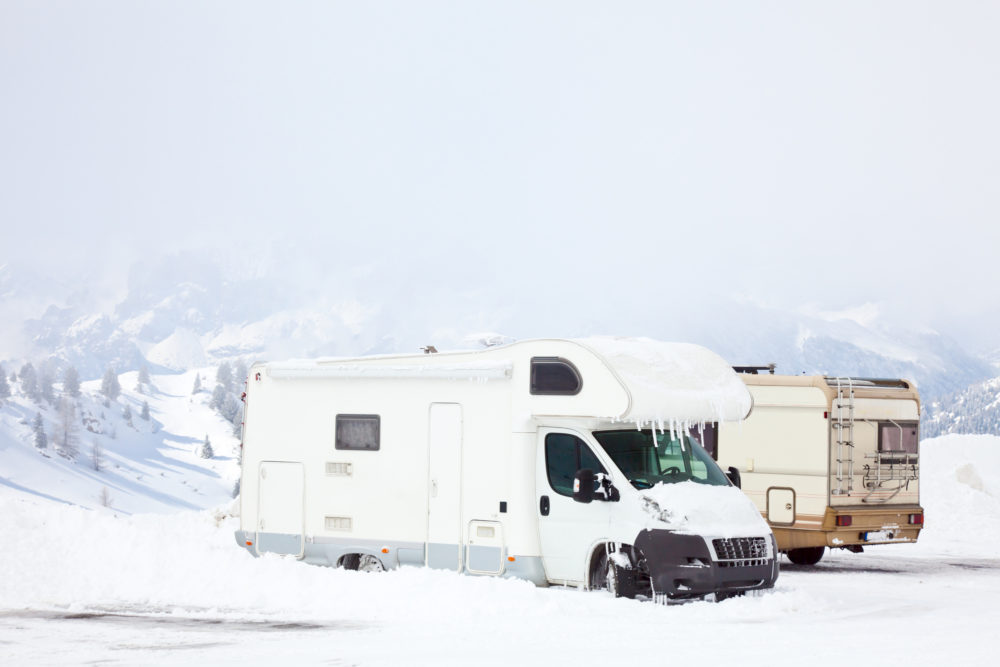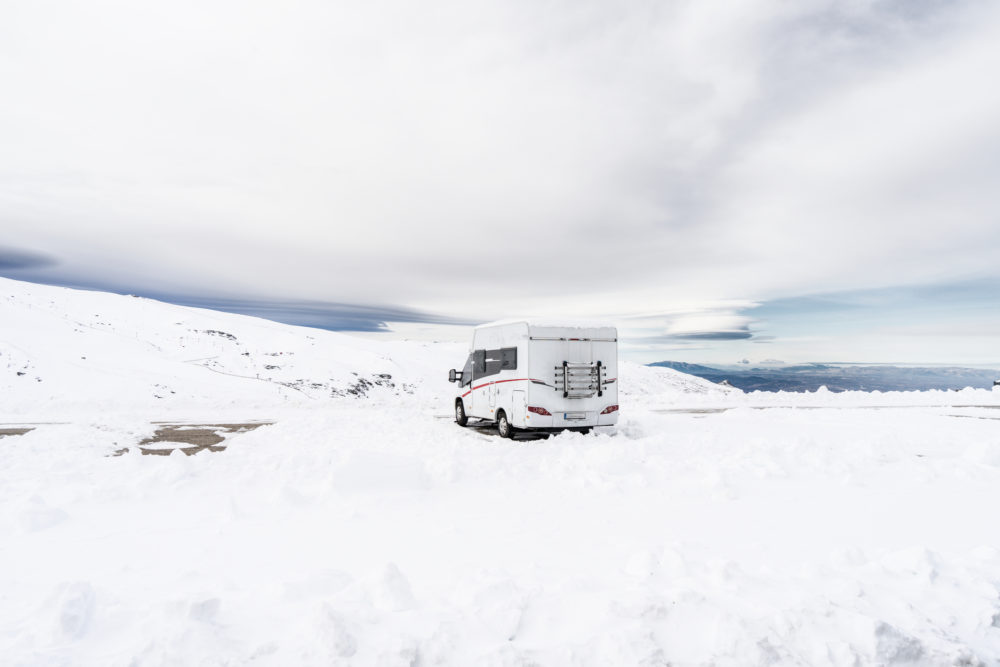Can An RV Freeze In One Night?
Can An RV Freeze In One Night?
The RV components can absolutely freeze in one night during a drastic drop in temperature overnight that lasts for more than 6 hours.
The components of the RV that are most prone to freezing are the water lines, as well as water holding tanks and external water hoses. For those who are new to the RV lifestyle and who are unaware of this possibility, this can become an expensive lesson to learn.

Contents
What Happens When RV Water Freezes?
When the water is stagnant (meaning, not moving through the plumbing) in the pipes, hoses and the holding tank, it freezes easily.
The RV plumbing that is filled with water will freeze in the lines and in the holding tank; the frozen water then expands and causes cracks and breaks in the material that the plumbing is made of (usually plastic/pex tubing).
Once the water unthaws, the stress damage from the expansion that caused tears, cracks and small breaks will lead to leaks. Some might be difficult to locate, as they might be small pinhole leaks; however, the water will start pooling overtime and the leak will have to be repaired.
How Cold Does It Have To Be Before RV Pipes Freeze?
The freezing temperature range starts at 32 F, but is for sure at 20 F and below.
Low temperatures, such as -20 to -30 F can cause serious damage to the RV, as those units are not built in a way to withstand such extremely low temperatures.
Water will not freeze in the pipes at temperatures above 32 F. However, if the temps hover at 32 F for an extended period of time (6-8 hours or more), water can begin to freeze in the RV plumbing and holding tank.
What To Do If Your RV Water Freezes?
You will know that your water lines are frozen when you try to turn on the water and it comes either as a trickle or no water at all. At that point, there is ice in the water lines.
To unfreeze your lines, you will have to increase the temperature of the lines to unthaw the ice in the lines. This can be done with heat tape, heat gun, hair dryer or by increasing the temperature in the RV around the water line.
If you have damage from water lines freezing, you will likely have either pinhole leaks or cracked lines that will leak and need to be repaired in order to use the RV plumbing.
Ways To Winterize Your RV
There are two different approaches to winterizing an RV: one is for the storing of the unit without any occupants for an extended time in freezing temperatures and the other is to avoid damage to the unit during freezing temperatures while occupying the RV.
Winterizing an RV for storage when not in use is seasonal winterization and consists of emptying all lines and appliances of water to prevent freezing and damage. After the plumbing system is entirely empty, the lines get filled with RV antifreeze.
The amount of antifreeze needed depends largely on the size of the unit and the holding tank, but on average, it is 2-3 gallons per unit.
Winterizing an RV as a means of preventing freezing damage to lines while occupying the unit in cold weather is a little different, since one continues to use the unit, including all amenities.
The components that need to be protected from freeze damage while living in an RV include the plumbing, the water holding tank and the external water hose connection to public utilities (if applicable).
When one is occupying the unit, the furnace will be automatically keeping the interior warmer than the temperature outside. It is critical to insulate the unit well to avoid excessive heat loss and pricey bills. Some RVers also use small electric space heaters in specific areas, such as the bedroom or bath, to avoid having to refill propane continuously.
This is especially helpful at RV parks where the electric cost is included in the fees, and not based on usage.
Some RVs have an arctic insulation package, which means that the underbelly is insulated and there is less heat loss through flooring, as compared to other units on the market.
It is beneficial to insulate the windows, vents, door and slideout areas, as well, to avoid drafts. There are many different products on the market, but many RVers choose a towel, a blanket or reflective paneling to place over drafty windows or seams.
RVers who set up camp for an extended period of time also often add RV skirting to avoid heat loss from the underbelly. This can be a professional custom product, or it can be as simple as adding hay bales or cardboard walls around the bottom of the RV.
One RV family survived a winter ice storm in Texas in 2021 (without any damage to their RV) that came on suddenly overnight and coated their whole RV in a sheet of ice. The key was to be proactive before the temps dropped drastically.
Here are the tips they followed:
- Open all the pantry/cabinetry doors under each sink. Allow the RV heating to heat up the cavity of that cabinet and keep the plumbing lines warmer. Yes, this will lead to some heating loss temporarily, but it is well worth it.
- Fill your freshwater tank and use the pump. Unhook from the RV park water supply.
- Empty and store away your external water hose, unless you have a way to insulate it. Some people have a heated water hose or use insulation, such as pool noodles to protect the water hose from freezing. The water hose would be empty either way, as this is the safest solution.
- Open the RV water spigot to drip slowly on nights with frost to prevent damage to the RV park water lines.
- If possible, you can use the same trick in your RV and keep the faucets at a trickle, but keep in mind your gray tank capacity. The last thing you want is to overfill those, as well.

How Much Does It Cost To Winterize Your RV?
If you have an RV dealership or a RV mobile tech winterizing your RV, it will cost anywhere between $130-$200+, depending on your location, the extent of winterization and the company’s rates. Keep in mind that you have to spend about the same amount in the spring for de-winterizing your RV, so the costs can really add up fast.
Therefore, you should consider winterizing your RV yourself; in this case, you have to purchase the materials (about $35) and invest your time to do it.
If you winterize the RV yourself, you will need to drain all the water from the lines, including all appliances and fluid points. Then you will need to flush the system with RV antifreeze, but make sure you bypass the water heater!
You should also remove any food etc. out of the camper, unplug any appliances, check for points of entry (and plug them) to avoid mice or other critters moving in, as well as ensuring that all the vents, doors and windows are fully sealed.
Some additional investments to help with the winterization process are:
- Water Heater Bypass Kit (if not installed)
- Water Pump Converter Kit (if not installed)
- Rodent Repellent (optional)
- RV Cover (optional)
FAQs:
Will RV pipes freeze at 32 degrees F?
Once the temperature dips to 32F degrees for a consistent 6-8 hours at a time, your RV pipes will freeze. Watch the weather forecast and be proactive to avoid RV pipe freeze.
Is RV antifreeze safe to drink?
The RV antifreeze is labeled non-toxic and biodegradable, which means it should be also safe for the environment, as well as limited or accidental human consumption. It is different from the toxic automotive antifreeze. That being said, no one should be drinking antifreeze “just because”.
Will RV antifreeze thaw frozen pipes?
The answer is no. Once the pipes are frozen, antifreeze cannot unthaw them. RV antifreeze only prevents the freezing of pipes. To unthaw frozen pipes, one can use a heater to warm up the surroundings (and the pipes indirectly), heat tape, heat gun or a hair dryer. Just make sure you do not damage the pipes with excessive heat exposure.
How do you get antifreeze out of the fresh water tank?
You will have to de-winterize your unit by flushing out the tank and the lines with water. Some people also use baking soda to neutralize and clean the tank and the lines so that the antifreeze is fully removed out of the system. One can sprinkle baking soda directly into each drain or even dissolve it in water first and pour it down the drains.
After that, you should flush the system again until the water tastes clean. It should be noted that instead of using your RV water pump to flush antifreeze from your camper’s water system, you can also use a garden hose or city water supply to flush the system.
What’s the best RV for winter living?
There are several brands that build RVs that include “all-season” prep, which includes a heated or insulated underbelly. Some brands and RV’s that are “all-season” RV are:
- Keystone Montana–Best Luxury.
- Northwood Arctic Fox–Best Budget.
- Forest River Cherokee Arctic Wolf–Best for Families.
- Oliver Legacy Elite–Best Compact.
- Jayco Eagle–Best for Extreme Weather.
- Lance 2295–Best for Milder Weather.
If you’re planning to spend some time in the colder climate states, you might want to consider purchasing one of these units.
“All-season” label does not mean that one should not winterize their RV, or insulate and protect from frost when in use, however. You should still perform proper maintenance to help extend the longevity and use of the RV, and to avoid expensive repairs.
